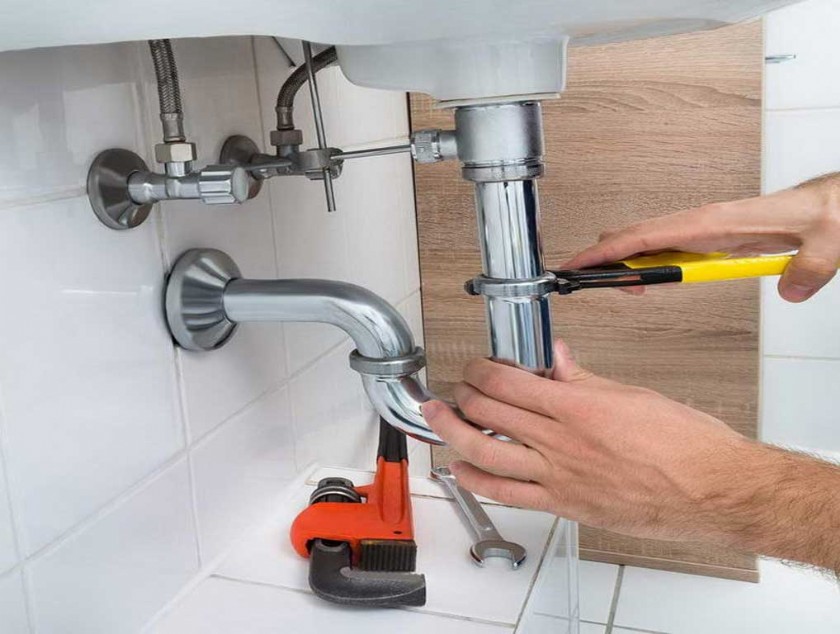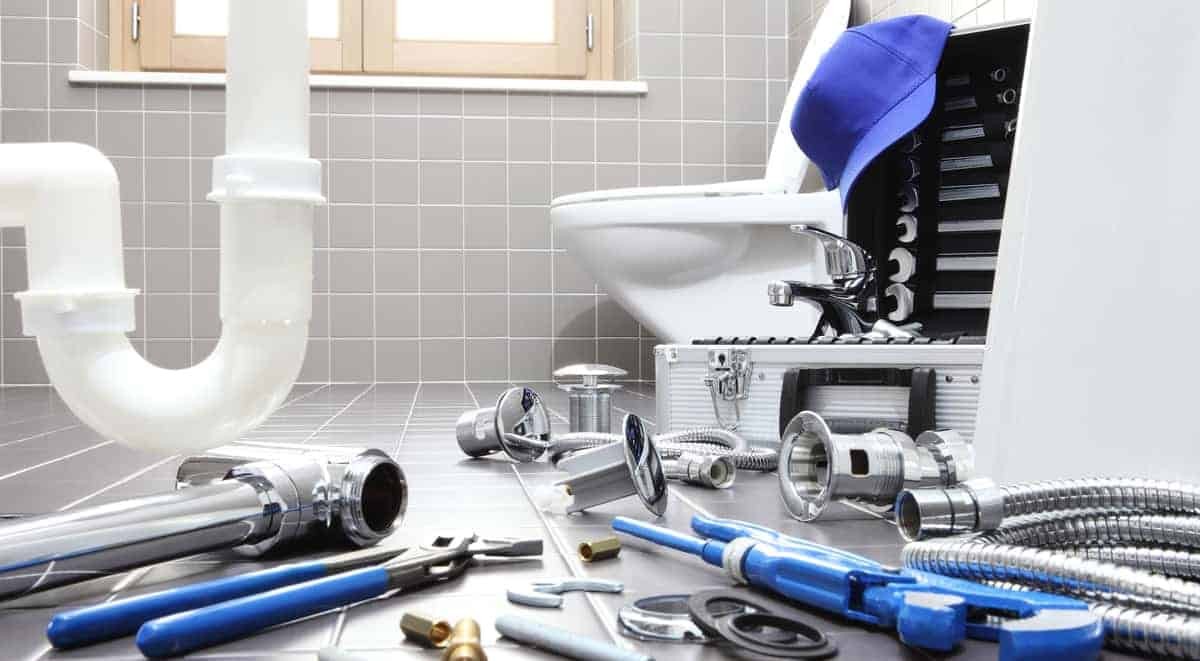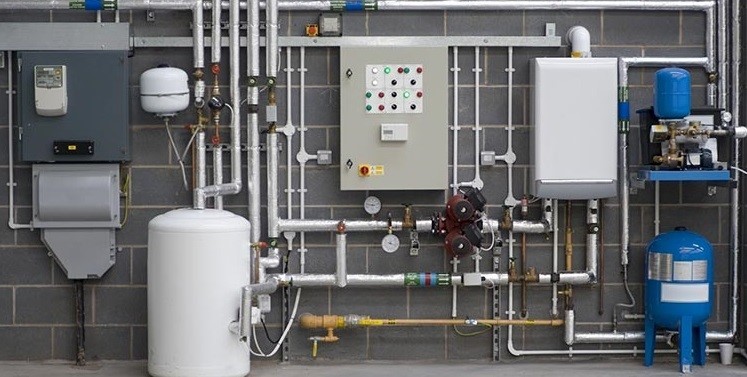
Plumbing is any system that conveys fluids for a wide range of applications. Plumbing uses pipes, valves, plumbing fixtures, tanks, and other apparatuses to convey fluids. Heating and cooling (HVAC), waste removal, and potable water delivery are among the most common uses for plumbing, but it is not limited to these applications. The word derives from the Latin for lead, plumbum, as the first effective pipes used in the Roman era were lead pipes.
In the developed world, plumbing infrastructure is critical to public health and sanitation.
Boilermakers and pipefitters are not plumbers although they work with piping as part of their trade and their work can include some plumbing.
Plumbing originated during ancient civilizations, as they developed public baths and needed to provide potable water and wastewater removal for larger numbers of people.
The Mesopotamians introduced the world to clay sewer pipes around 4000 BCE, with the earliest examples found in the Temple of Bel at Nippur and at Eshnunna, used to remove wastewater from sites, and capture rainwater, in wells. The city of Uruk contains the oldest known examples of brick constructed Latrines, constructed atop interconnecting fired clay sewer pipes, c.3200 BCE. Clay pipes were later used in the Hittite city of Hattusa. They had easily detachable and replaceable segments, and allowed for cleaning.
Standardized earthen plumbing pipes with broad flanges making use of asphalt for preventing leakages appeared in the urban settlements of the Indus Valley Civilization by 2700 BC.
Copper piping appeared in Egypt by 2400 BCE, with the Pyramid of Sahure and adjoining temple complex at Abusir, found to be connected by a copper waste pipe.
The word "plumber" dates from the Roman Empire. The Latin for lead is plumbum. Roman roofs used lead in conduits and drain pipes and some were also covered with lead. Lead was also used for piping and for making baths.
Plumbing reached its early apex in ancient Rome, which saw the introduction of expansive systems of aqueducts, tile wastewater removal, and widespread use of lead pipes. The Romans used lead pipe inscriptions to prevent water theft. With the Fall of Rome both water supply and sanitation stagnated—or regressed—for well over 1,000 years. Improvement was very slow, with little effective progress made until the growth of modern densely populated cities in the 1800s. During this period, public health authorities began pressing for better waste disposal systems to be installed, to prevent or control epidemics of disease. Earlier, the waste disposal system had consisted of collecting waste and dumping it on the ground or into a river. Eventually the development of separate, underground water and sewage systems eliminated open sewage ditches and cesspools.
Most large cities today pipe solid wastes to sewage treatment plants in order to separate and partially purify the water, before emptying into streams or other bodies of water. For potable water use, galvanized iron piping was commonplace in the United States from the late 1800s until around 1960. After that period, copper piping took over, first soft copper with flared fittings, then with rigid copper tubing using soldered fittings.
The use of lead for potable water declined sharply after World War II because of increased awareness of the dangers of lead poisoning. At this time, copper piping was introduced as a better and safer alternative to lead pipes.

The major categories of plumbing systems or subsystems are:
"Water pipe" redirects here. It may also refer to ahookahor abong.
A water pipe is a pipe or tube, frequently made of plastic or metal, that carries pressurized and treated fresh water to a building (as part of a municipal water system), as well as inside the building.
The difference between pipes and tubes is a matter of sizing. For instance, PVC pipe for plumbing applications and galvanized steel pipe are measured in iron pipe size (IPS). Copper tube, CPVC, PeX and other tubing is measured nominally, basically an average diameter. These sizing schemes allow for universal adaptation of transitional fittings. For instance, 1/2" PeX tubing is the same size as 1/2" copper tubing. 1/2" PVC on the other hand is not the same size as 1/2" tubing, and therefore requires either a threaded male or female adapter to connect them. When used in agricultural irrigation, the singular form "pipe" is often used as a plural.
Pipe is available in rigid joints, which come in various lengths depending on the material. Tubing, in particular copper, comes in rigid hard tempered joints or soft tempered (annealed) rolls. PeX and CPVC tubing also comes in rigid joints or flexible rolls. The temper of the copper, whether it is a rigid joint or flexible roll, does not affect the sizing.
The thicknesses of the water pipe and tube walls can vary. Because piping and tubing are commodities, having a greater wall thickness implies higher initial cost. Thicker walled pipe generally implies greater durability and higher pressure tolerances. Pipe wall thickness is denoted by various schedules or for large bore polyethylene pipe in the UK by the Standard Dimension Ratio (SDR), defined as the ratio of the pipe diameter to its wall thickness. Pipe wall thickness increases with schedule, and is available in schedules 20, 40, 80, and higher in special cases. The schedule is largely determined by the operating pressure of the system, with higher pressures commanding greater thickness. Copper tubing is available in four wall thicknesses: type DWV (thinnest wall; only allowed as drain pipe per UPC), type 'M' (thin; typically only allowed as drain pipe by IPC code), type 'L' (thicker, standard duty for water lines and water service), and type 'K' (thickest, typically used underground between the main and the meter).
Wall thickness does not affect pipe or tubing size. 1/2" L copper has the same outer diameter as 1/2" K or M copper. The same applies to pipe schedules. As a result, a slight increase in pressure losses is realized due to a decrease in flowpath as wall thickness is increased. In other words, 1 foot of 1/2" L copper has slightly less volume than 1 foot of 1/2 M copper.
Water systems of ancient times relied on gravity for the supply of water, using pipes or channels usually made of clay, lead, bamboo, wood, or stone. Hollowed wooden logs wrapped in steel banding were used for plumbing pipes, particularly water mains. Logs were used for water distribution in England close to 500 years ago. US cities began using hollowed logs in the late 1700s through the 1800s. Today, most plumbing supply pipe is made out of steel, copper, and plastic; most waste (also known as "soil") out of steel, copper, plastic, and cast iron.
The straight sections of plumbing systems are called "pipes" or "tubes". A pipe is typically formed via casting or welding, whereas a tube is made through extrusion. Pipe normally has thicker walls and may be threaded or welded, while tubing is thinner-walled and requires special joining techniques such as brazing, compression fitting, crimping, or for plastics, solvent welding. These joining techniques are discussed in more detail in the piping and plumbing fittings article.
Galvanized steel potable water supply and distribution pipes are commonly found with nominal pipe sizes from 3⁄8 inch (9.5mm) to 2 inches (51mm). It is rarely used today for new construction residential plumbing. Steel pipe has National Pipe Thread (NPT) standard tapered male threads, which connect with female tapered threads on elbows, tees, couplers, valves, and other fittings. Galvanized steel (often known simply as "galv" or "iron" in the plumbing trade) is relatively expensive, and difficult to work with due to weight and requirement of a pipe threader. It remains in common use for repair of existing "galv" systems and to satisfy building code non-combustibility requirements typically found in hotels, apartment buildings and other commercial applications. It is also extremely durable and resistant to mechanical abuse. Black lacquered steel pipe is the most widely used pipe material for fire sprinklers and natural gas.
Most typical single family home systems won't require supply piping larger than 3⁄4 inch (19mm) due to expense as well as steel piping's tendency to become obstructed from internal rusting and mineral deposits forming on the inside of the pipe over time once the internal galvanizing zinc coating has degraded. In potable water distribution service, galvanized steel pipe has a service life of about 30 to 50 years, although it is not uncommon for it to be less in geographic areas with corrosive water contaminants.
Copper pipe and tubing was widely used for domestic water systems in the latter half of the twentieth century. Demand for copper products has fallen due to the dramatic increase in the price of copper, resulting in increased demand for alternative products including PEX and stainless steel.

Plastic pipe is in wide use for domestic water supply and drain-waste-vent (DWV) pipe. Principal types include: Polyvinyl chloride (PVC) was produced experimentally in the 19th century but did not become practical to manufacture until 1926, when Waldo Semon of BF Goodrich Co. developed a method to plasticize PVC, making it easier to process. PVC pipe began to be manufactured in the 1940s and was in wide use for Drain-Waste-Vent piping during the reconstruction of Germany and Japan following WWII. In the 1950s, plastics manufacturers in Western Europe and Japan began producing acrylonitrile butadiene styrene (ABS) pipe. The method for producing cross-linked polyethylene (PEX) was also developed in the 1950s. Plastic supply pipes have become increasingly common, with a variety of materials and fittings employed.
Present-day water-supply systems use a network of high-pressure pumps, and pipes in buildings are now made of copper,brass, plastic (particularlycross-linked polyethylenecalled PEX, which is estimated to be used in 60% of single-family homes), or other nontoxic material. Due to itstoxicity, most cities moved away from lead water-supply piping by the 1920s in the United States,although lead pipes were approved by national plumbing codes into the 1980s,and lead was used in plumbing solder for drinking water until it was banned in 1986.Drain and vent lines are made of plastic, steel, cast iron, or lead.
Plumbing equipment includes devices often behind walls or in utility spaces which are not seen by the general public. It includes water meters, pumps, expansion tanks, back flow preventers, water filters, UV sterilization lights, water softeners, water heaters, heat exchangers, gauges, and control systems.
There are many tools a plumber needs to do a good plumbing job. While many simple plumbing tasks can be completed with a few common hand held tools, other more complex jobs require specialised tools, designed specifically to make the job easier.
Specialized plumbing tools include pipe wrenches, flaring pliers, pipe vise, pipe bending machine, pipe cutter, dies, and joining tools such as soldering torches and crimp tools. New tools have been developed to help plumbers fix problems more efficiently. For example, plumbers use video cameras for inspections of hidden leaks or other problems; they also use hydro jets, and high pressure hydraulic pumps connected to steel cables for trench-less sewer line replacement.
Flooding from excessive rain or clogged sewers may require specialized equipment, such as a heavy duty pumper truck designed to vacuum raw sewage.
Bacteria have been shown to live in "premises plumbing systems". The latter refers to the "pipes and fixtures within a building that transport water to taps after it is delivered by the utility". Community water systems have been known for centuries to spread waterborne diseases like typhoid and cholera. However, "opportunistic premises plumbing pathogens" have been recognized only more recently: Legionella pneumophila, discovered in 1976, Mycobacterium avium, and Pseudomonas aeruginosa are the most commonly tracked bacteria, which people with depressed immunity can inhale or ingest and may become infected with. Some of the locations where these opportunistic pathogens can grow include faucets, shower heads, water heaters and along pipe walls. Reasons that favor their growth are "high surface-to-volume ratio, intermittent stagnation, low disinfectant residual, and warming cycles". A high surface-to-volume ratio, i.e. a relatively large surface area allows the bacteria to form a biofilm, which protects them from disinfection.
Plumbing equipment includes devices often behind walls or in utility spaces which are not seen by the general public. It includes water meters, pumps, expansion tanks, back flow preventers, water filters, UV sterilization lights, water softeners, water heaters, heat exchangers, gauges, and control systems.
Plumbing equipment includes devices often behind walls or in utility spaces which are not seen by the general public. It includes water meters, pumps, expansion tanks, back flow preventers, water filters, UV sterilization lights, water softeners, water heaters, heat exchangers, gauges, and control systems.
Plumbing equipment includes devices often behind walls or in utility spaces which are not seen by the general public. It includes water meters, pumps, expansion tanks, back flow preventers, water filters, UV sterilization lights, water softeners, water heaters, heat exchangers, gauges, and control systems.
 82 times.
82 times.
Learn how to fix a leaking washing machine hose yourself with these DIY methods. Save time and money by following these easy steps at home.
/ Washing machine hose repair Answers: 0 654
654
Signs like reduced hot water supply, strange noises, leaks, and higher utility bills indicate it's time to replace an aging water heating system.
/ Age of water heating system Answers: 0 623
623
Protect your home and garden from winter freezes by taking important steps like insulating pipes, covering delicate plants, and using mulch to prevent damage and ensure plant survival.
/ Preparing for winter freezes Answers: 0 710
710
Learn how to detect and fix pressure relief valve issues in a system to prevent safety risks and equipment failures. Stay proactive and ensure system efficiency.
/ Pressure relief valve problems Answers: 0 570
570
Learn how to protect your plumbing from freezing temperatures this winter. Follow these steps to prevent frozen pipes and costly damage to your home.
/ Winterizing your plumbing Answers: 0 656
656
Learn how to effectively repair a leaking washing machine hose to avoid flooding and water damage. Follow these tips to fix the issue and protect your home.
/ Washing machine hose repair Answers: 0 589
589
Learn how to effectively repair a leaking washing machine hose to avoid flooding and water damage. Follow these tips to fix the issue and protect your home.
/ Washing machine hose repair Answers: 0 682
682
Discover common signs of malfunction in gas or electric heating elements, and learn how to troubleshoot and repair the issue effectively.
/ Gas or electric heating element problems Answers: 0 705
705
Learn how to prevent frozen plumbing during winter by insulating pipes, keeping faucets dripping, and using heat tape. Act quickly if pipes freeze to avoid costly damage.
/ Dealing with frozen plumbing Answers: 0 668
668
Protect your pipes from freezing in cold weather with insulation, heat tape, and letting faucets drip. Prevent costly repairs by taking proactive measures.
/ Cold weather pipe protection Answers: 0 542
542
Discover common signs of pressure relief valve issues & learn how to resolve them effectively. Prevent hazardous situations with proper maintenance.
/ Pressure relief valve problems Answers: 0 1032
1032
Learn how to identify common signs of electrical problems in a water heater, such as no hot water or unusual noises, and discover how to diagnose and resolve them effectively.
/ Electrical problems in water heater Answers: 1 410
410
Learn how to prevent pipes from freezing during cold weather to avoid costly damage in your home. From insulating pipes to keeping faucets dripping, these tips can help protect your plumbing.
/ Protecting pipes from cold Answers: 1 401
401
Learn how to install a water filter system in your home with our step-by-step guide for clean and safe drinking water. Have peace of mind knowing your water is free from harmful contaminants.
/ Water filter installation Answers: 1 279
279
Learn why your pilot light keeps going out on your appliance and get tips on how to fix it so it can stay lit consistently. Rest assured with our troubleshooting guide.
/ Pilot light won't stay lit Answers: 1 367
367
tepte.com: Your Questions and Answers Resource with a Wealth of General Knowledge
Are you seeking a one-stop destination for comprehensive knowledge and answers to your burning questions? Look no further than tepte.com! Our platform is your go-to source for a wide range of information, all conveniently presented in an easily accessible question and answer format.
At tepte.com, we pride ourselves on being your reliable knowledge hub. Whether you're curious about technology, science, history, or any other subject under the sun, our extensive General Knowledge (GK) knowledge base has you covered. We've made it our mission to provide you with in-depth insights and facts on an array of topics. Read more